初中英语语音的知识点(2)
初中英语语音知识点梳理
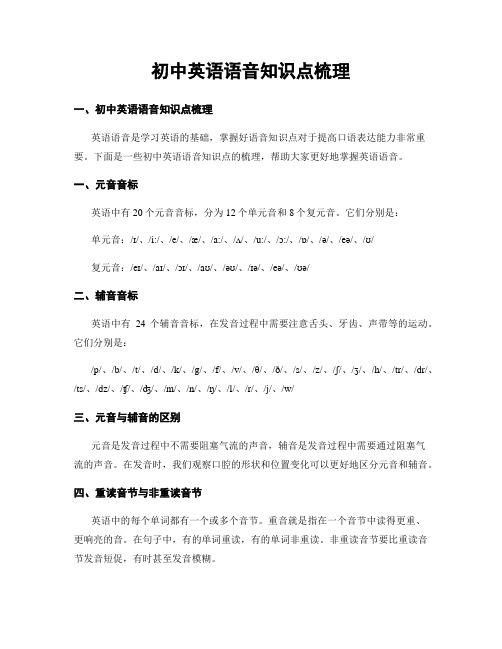
初中英语语音知识点梳理一、初中英语语音知识点梳理英语语音是学习英语的基础,掌握好语音知识点对于提高口语表达能力非常重要。
下面是一些初中英语语音知识点的梳理,帮助大家更好地掌握英语语音。
一、元音音标英语中有20个元音音标,分为12个单元音和8个复元音。
它们分别是:单元音:/ɪ/、/i:/、/e/、/æ/、/a:/、/ʌ/、/u:/、/ɔ:/、/ɒ/、/ə/、/eə/、/ʊ/复元音:/eɪ/、/aɪ/、/ɔɪ/、/aʊ/、/əʊ/、/ɪə/、/eə/、/ʊə/二、辅音音标英语中有24个辅音音标,在发音过程中需要注意舌头、牙齿、声带等的运动。
它们分别是:/p/、/b/、/t/、/d/、/k/、/g/、/f/、/v/、/θ/、/ð/、/s/、/z/、/ʃ/、/ʒ/、/h/、/tr/、/dr/、/ts/、/dz/、/ʧ/、/ʤ/、/m/、/n/、/ŋ/、/l/、/r/、/j/、/w/三、元音与辅音的区别元音是发音过程中不需要阻塞气流的声音,辅音是发音过程中需要通过阻塞气流的声音。
在发音时,我们观察口腔的形状和位置变化可以更好地区分元音和辅音。
四、重读音节与非重读音节英语中的每个单词都有一个或多个音节。
重音就是指在一个音节中读得更重、更响亮的音。
在句子中,有的单词重读,有的单词非重读。
非重读音节要比重读音节发音短促,有时甚至发音模糊。
五、长短音节在英语中,有些单音节词的元音比较长,有些则比较短。
比如:“tea”中的 /i:/比较长,“sit”中的 /ɪ/比较短。
长短音节的发音时间是不同的,需要我们仔细区分。
六、连读连读是英语语音中常用的一种特殊现象,指相邻两个单词的辅音之间变得模糊不清。
例如:“I am”连读成 /aɪəm/,“do you”连读成 /dʊ/七、浊音与清音在发音时,有些辅音音标需要振动声带,称为浊音;而有些辅音音标则声带不振动,称为清音。
如:“big”中的 /b/是浊音,“pen”中的 /p/是清音。
初中英语听说知识点总结

初中英语听说知识点总结一、语音知识1. 音素与音标:掌握英语基本音素,能够正确读出单词的音标。
2. 音节与重音:了解单词的音节构成,识别并正确使用单词的重音。
3. 连读与失爆:在口语中,掌握连读技巧,了解在哪些情况下可以省略某些音的发音。
4. 语调和节奏:理解英语的基本语调模式,如升调、降调,并能在口语交流中运用适当的语调和节奏。
二、听力技巧1. 预测与猜测:在听力练习中,通过上下文线索预测和猜测信息。
2. 捕捉关键信息:学会在听力材料中快速识别并记住关键词汇和信息。
3. 笔记技巧:掌握基本的听力笔记技巧,能够在听的同时记录重要信息。
4. 听力理解策略:运用不同的听力策略,如扫听、精听和推理,提高理解能力。
三、口语表达1. 基本句型:掌握常见的英语句型结构,如陈述句、疑问句、否定句等。
2. 时态运用:能够准确使用一般现在时、一般过去时、现在进行时等基本时态。
3. 常用表达:学习并运用日常交流中的常用表达,如问候、自我介绍、表达意见等。
4. 情景对话:通过模拟不同情景下的对话,提高口语应变能力和交际技巧。
四、听力材料类型1. 对话类材料:理解日常生活中的对话,如购物、问路、订餐等。
2. 短文类材料:听懂短篇文章的主旨大意,如故事、新闻报道、讲座等。
3. 图片类材料:通过观察图片内容,理解相关的英语描述和说明。
4. 视频类材料:能够理解视频内容,包括人物对话、情景再现等。
五、口语练习方法1. 模仿练习:通过模仿英语母语者的发音和语调,提高口语的自然度。
2. 角色扮演:参与角色扮演活动,模拟真实交流场景,增强口语实践能力。
3. 小组讨论:参与小组讨论,与同学交流思想,锻炼口语表达和听力理解能力。
4. 公开演讲:进行简短的英语演讲,提高语言组织能力和自信心。
六、常见问题及应对策略1. 词汇量不足:通过阅读、记忆和使用新词汇,不断扩大词汇量。
2. 语法错误:学习和复习英语语法规则,通过练习减少错误。
3. 发音不准确:多听标准发音,通过跟读和模仿纠正发音。
初中英语语音语调知识点整理与归纳
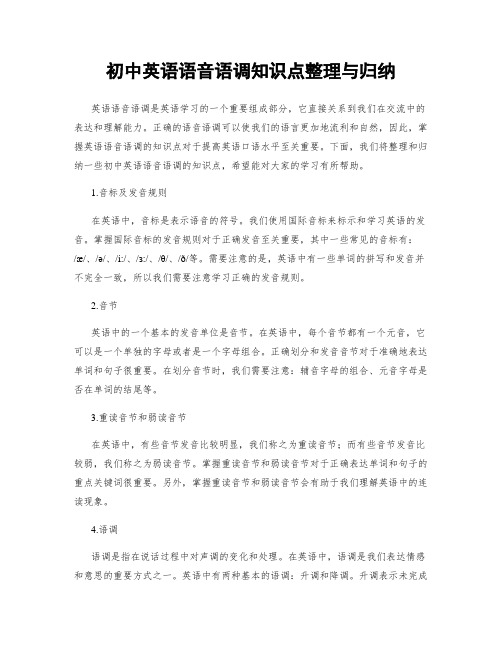
初中英语语音语调知识点整理与归纳英语语音语调是英语学习的一个重要组成部分,它直接关系到我们在交流中的表达和理解能力。
正确的语音语调可以使我们的语言更加地流利和自然,因此,掌握英语语音语调的知识点对于提高英语口语水平至关重要。
下面,我们将整理和归纳一些初中英语语音语调的知识点,希望能对大家的学习有所帮助。
1.音标及发音规则在英语中,音标是表示语音的符号。
我们使用国际音标来标示和学习英语的发音。
掌握国际音标的发音规则对于正确发音至关重要,其中一些常见的音标有:/æ/、/ə/、/i:/、/ɜ:/、/θ/、/ð/等。
需要注意的是,英语中有一些单词的拼写和发音并不完全一致,所以我们需要注意学习正确的发音规则。
2.音节英语中的一个基本的发音单位是音节。
在英语中,每个音节都有一个元音,它可以是一个单独的字母或者是一个字母组合。
正确划分和发音音节对于准确地表达单词和句子很重要。
在划分音节时,我们需要注意:辅音字母的组合、元音字母是否在单词的结尾等。
3.重读音节和弱读音节在英语中,有些音节发音比较明显,我们称之为重读音节;而有些音节发音比较弱,我们称之为弱读音节。
掌握重读音节和弱读音节对于正确表达单词和句子的重点关键词很重要。
另外,掌握重读音节和弱读音节会有助于我们理解英语中的连读现象。
4.语调语调是指在说话过程中对声调的变化和处理。
在英语中,语调是我们表达情感和意思的重要方式之一。
英语中有两种基本的语调:升调和降调。
升调表示未完成的意思或者是疑问句的陈述部分,而降调表示已完成的意思或者是陈述句的陈述部分。
5.连读连读是英语中一个常见的语音现象。
当一个词的末尾是辅音,而下一个词的开头是元音时,这两个词会连在一起发音。
正确地掌握连读可以使我们的语言更加地流利和自然。
6.元音的弱化在英语中,连读和弱读的现象使得有些元音的发音会弱化,这在口语中是很常见的。
当一个元音没有强调时,它会发出一个较弱的音。
初中英语语音基础知识
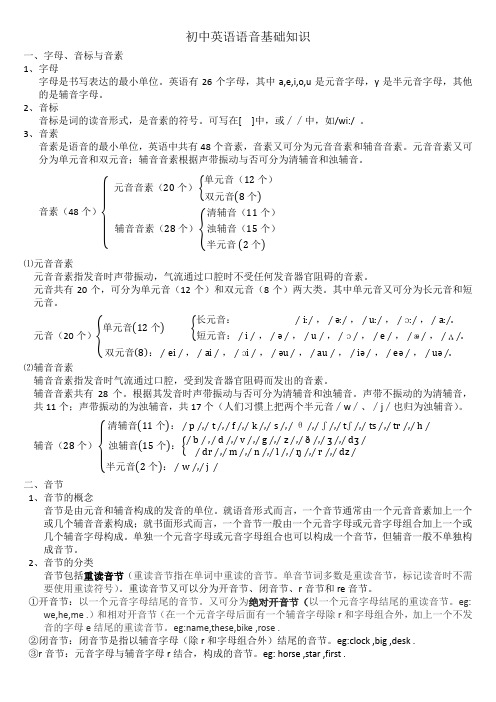
初中英语语音基础知识一、字母、音标与音素1、字母字母是书写表达的最小单位。
英语有26个字母,其中a,e,i,o,u是元音字母,y是半元音字母,其他的是辅音字母。
2、音标音标是词的读音形式,是音素的符号。
可写在[ ]中,或∕∕中,如/wi:/ 。
3、音素音素是语音的最小单位,英语中共有48个音素,音素又可分为元音音素和辅音音素。
元音音素又可分为单元音和双元音;辅音音素根据声带振动与否可分为清辅音和浊辅音。
音素(48个){元音音素(20个){单元音(12个)双元音(8个) 辅音音素(28个){清辅音(11个)浊辅音(15个)半元音 (2个)⑴元音音素元音音素指发音时声带振动,气流通过口腔时不受任何发音器官阻碍的音素。
元音共有20个,可分为单元音(12个)和双元音(8个)两大类。
其中单元音又可分为长元音和短元音。
元音(20个){单元音(12个) {长元音:∕i:∕,∕ə:∕,∕u:∕,∕ɔ:∕,∕a:∕.短元音:∕i∕,∕ə∕,∕u∕,∕ɔ∕,∕e∕,∕æ∕,∕ʌ双元音(8):∕ei∕,∕ai∕,∕ɔi∕,∕əu∕,∕au∕,∕iə∕,∕eə∕,∕uə∕.∕.⑵辅音音素辅音音素指发音时气流通过口腔,受到发音器官阻碍而发出的音素。
辅音音素共有28个。
根据其发音时声带振动与否可分为清辅音和浊辅音。
声带不振动的为清辅音,共11个;声带振动的为浊辅音,共17个(人们习惯上把两个半元音∕w∕、∕j∕也归为浊辅音)。
辅音(28个){清辅音(11个):∕p∕,∕t∕,∕f∕,∕k∕,∕s∕,∕θ∕,∕ʃ∕,∕tʃ∕,∕ts∕,∕tr∕,∕h∕浊辅音(15个):{∕b∕ ,∕d∕,∕v∕,∕g∕,∕z∕,∕ð∕,∕ʒ∕,∕dʒ∕∕dr∕,∕m∕,∕n∕,∕l∕,∕ŋ∕,∕r∕,∕dz∕半元音(2个):∕w∕,∕j ∕二、音节1、音节的概念音节是由元音和辅音构成的发音的单位。
就语音形式而言,一个音节通常由一个元音音素加上一个或几个辅音音素构成;就书面形式而言,一个音节一般由一个元音字母或元音字母组合加上一个或几个辅音字母构成。
八年级言爱版英语知识点

八年级言爱版英语知识点八年级英语是初中英语学习中的一个重要阶段,是为高中英语奠定基础的阶段。
言爱版八年级英语教材内容涵盖了语音、词汇、语法、听说读写等方面的知识点,下面将详细介绍这些知识点。
一、语音语音是语言的基础,八年级英语语音知识点主要包括英语音标、重读音节和连读。
1. 英语音标英语中有26个字母,但是和26个发音不完全对应,要想正确发音,需要掌握英语音标。
英语音标分为元音和辅音。
元音包括长元音和短元音,辅音包括爆破音、摩擦音和鼻音等。
2. 重读音节英语的重音是指在一个词中,发音强调的部分。
在大多数情况下,英语的重音在单词的第一音节上。
3. 连读连读是指说英语时,两个单词之间的边界模糊,通常快速说出来的现象。
连读的形式包括连音和弱化。
二、词汇八年级英语词汇量的要求逐渐提高,需要学生掌握更多的词汇,才能更好的理解和阅读英语。
八年级英语词汇点主要包括词性、形容词和副词的比较级和最高级、介词短语、固定短语和常用词组等。
1. 词性英语中的词性有名词、动词、形容词、副词、代词等,需要准确理解和辨析。
2. 形容词和副词的比较级和最高级形容词和副词的比较级和最高级是指在形容词和副词前面加上-er和-est来表示两个或多个事物之间的比较。
在使用上需要掌握规则和注意音节。
3. 介词短语介词短语是由一个介词和其所需要的名词或代词组成的短语,需要准确识别和掌握。
4. 固定短语和常用词组固定短语和常用词组是英语中常用的短语和词组,如“watch TV”、“play basketball”等,需要掌握和灵活运用。
三、语法语法是英语学习中的重要部分,需要学生掌握各种语法规则和句型。
八年级英语语法知识点主要包括时态、情态动词、虚拟语气、被动语态和复合句等。
1. 时态时态是指动词在句中所表示的时间,包括一般现在时、一般过去时、一般将来时、现在进行时、过去进行时和过去将来时等,需要掌握各种时态的用法和结构。
2. 情态动词情态动词是用来表示某种情态或语气的动词,如can、may、must等,需要掌握其用法和语气。
初中英语语音的知识点总复习有答案(2)
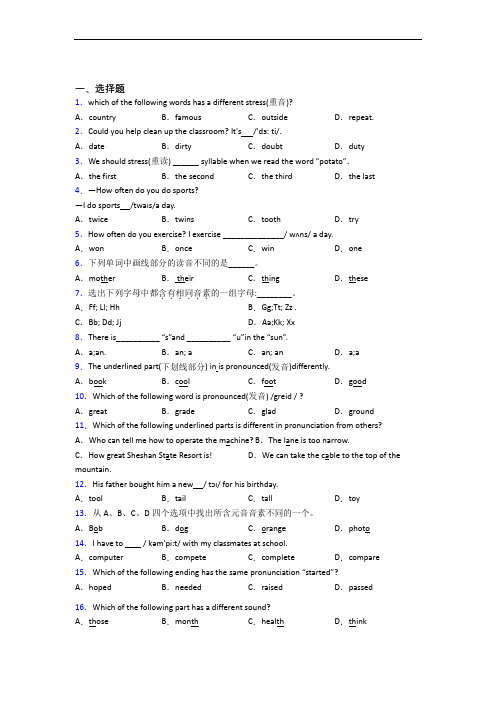
一、选择题1.which of the following words has a different stress(重音)?A.country B.famous C.outside D.repeat. 2.Could you help clean up the classroom? It's /'dɜ: ti/.A.date B.dirty C.doubt D.duty3.We should stress(重读) ______ syllable when we read the wo rd “potato”.A.the first B.the second C.the third D.the last 4.—How often do you do sports?—I do sports /twaɪs/a day.A.twice B.twins C.tooth D.try5.How often do you exercise? I exercise ______________/ wʌns/ a day.A.won B.once C.win D.one6.下列单词中画线部分的读音不同的是______。
A.mother B. their C.thing D.these7.选出下列字母中都含有相同音素......的一组字母:________。
A.Ff; Ll; Hh B.Gg;Tt; Zz .C.Bb; Dd; Jj D.Aa;Kk; Xx8.There is__________ “s”and __________ “u”in the “sun”.A.a;an. B.an; a C.an; an D.a;a9.The underlined part(下划线部分) in is pronounced(发音)differently.A.book B.cool C.foot D.good 10.Which of the following word is pronounced(发音) /greid / ?A.great B.grade C.glad D.ground 11.Which of the following underlined parts is different in pronunciation from others? A.Who can tell me how to operate the machine? B.The lane is too narrow.C.How great Sheshan State Resort is! D.We can take the cable to the top of the mountain.12.His father bought him a new / tɔɪ/ for his birthday.A.tool B.tail C.tall D.toy13.从A、B、C、D四个选项中找出所含元音音素不同的一个。
初中英语语音的解析含答案(2)
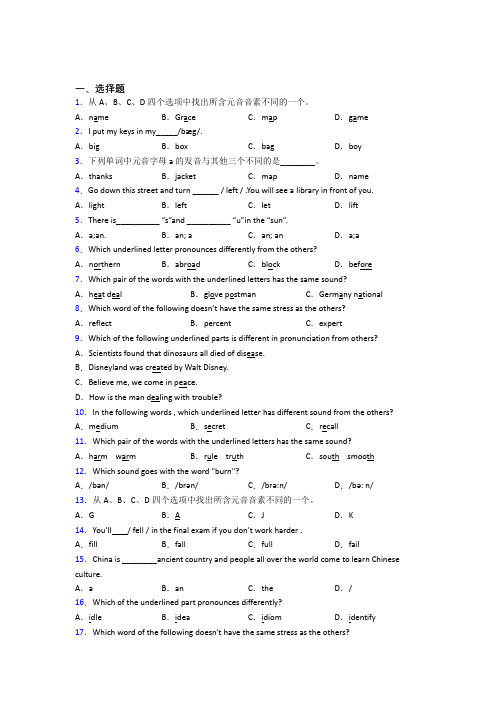
解析:B
【解析】
【详解】
句意:中国是一个古老的国家,全世界的人都来学习中国文化。
考查冠词词义辨析。a一个,不定冠词,放在辅音音素开头的单词前面;an一个,不定冠词,放在元音音素开头的单词前面;the定冠词,表示特指,世界上独一无二的东西。中国是古文化国家之一,选择不定冠词。Ancient单词中第一个字母a发元音/eɪ/。故选B。
考查冠词和字母发音。字母s的发音是[es],以元音发音开头,所以用an;字母u的发音是[ju:],辅音发音开头,所以用a,故选B。
【点睛】
使用不定冠词a或者an来表示“一个”时,如果字母或者单词以元音发音开头,而不是根据元音字母开头,则用an。比如本题,虽然s是元音字母,但是发音为[es],以元音发音开头,所以用an;字母u虽然是元音字母,但是发音是[ju:],辅音发音开头,所以用a。
23.Which of the underlined vowel(s) has a different sound?
A.theseB.e-dogC.freeD.enjoy
24.I have a pet/ kæt / , it’s very smart .
A.catB.cutC.coatD.cute
25.从A、B、C、D四个选项中找出所含元音音素不同的一个。
A.SubjectB.ProductC.Request
18.Which has the different sound of the letter group ‘igh’ from the other words?
A.highB.nightC.weightD.right
19.Health is more important than__________/welθ/.
初中英语教资考试知识点超详细考点总结

第一部分语言知识与能力第一章英语语言知识二、语音(Speech Sounds)P781、语音分类发音方式发音部位VL - 清浊音(voiceless consonant) VD - 浊辅音(voiced consonant)2、音系学(phonology)P79(1)同化规则(assimilation Rule)progressive assimilation 顺同化(前面带偏后面)workedregressive assimilation 逆同化(后面带偏前面)newspaperreciprocal/double assimilation 互相同化 did you(2)音节(syllable) tea chi-na im-pos-si-ble重音(stress)声调(tone)(3)语音变化(vocal variety)liaison 连读 pick it upplosion 爆破音plosion loss 失去爆破 sit down ;incomplete plosion 不完全爆破 ask ed nasal plosion 鼻腔爆破 button ;lateral plosion 舌边爆破 little三、形态学(Morphology)1、morpheme 词素重点! P87(1)free morpheme 自由词素 dog ;bound morpheme 黏着词素 moonwalk(2)root 词根; affix 词缀(prefix 前缀、suffix 后缀); stem 词干friend-ships(3)inflectional affix 屈折词缀 -s,-ing,-ed不同形式(4)derivational affix 派生词缀改变词性和意义2、(1)inflection 屈折变化 -s,-ing,-ed不同形式(2)word-formation 词的形成:compounding 复合法 through-outderivation 派生法(prefixation 前缀化 suffixation 后缀化)il-logical-ly3、常见构词法P89invention 新创词 nylon ;blending 混成法 smoke+fog=smogclipping 截断法 advertisement=ad ;initialism 首字母连写词 WTOacronym 首字母拼音词 AIDS ;back-formation 逆构词法 editor--editanalogical creation 类似构词 work--wrought/workedtypes of borrowing 借词法:loanword/borrowing 借词 feast(法语中借来)loanblend 混合借词 Chinatown (本国加外来)loanshift 转移借词 bridge (借用意义)loan translation 翻译借词(从别种语言翻译而来)4、词义变化broadening 词义扩大 bird 小鸟--鸟类;narrowing 词义缩小 girl 年轻人--女孩meaning shift 词义转移;class shift 词性转换;folk etymology 俗词源(错多了成了对的)四、句法学(Syntax) P911、句法关系syntagmatic relation 组合关系(horizontal relation/chain relation)构成同一形式、序列或结构paradigmatic relation 聚合关系(vertical relation/choice relation)各要素可相互替换relation of co-occurrence 共现关系(不同集合的词语一起组成句子)2、句子结构和成分immediate constituent analysis 直接成分分析法(IC分析法)The boy ate the apple. 用树形图(tree diagram)一般句子,主谓宾之类的endocentric construction 向心结构一个词或词组可以确定为中心(center)或中心词(head)two stone bridge 一般名词/动词/形容词短语exocentric construction 离心结构没有确定的中心或中心词 The boy smiled. 一般动宾/系表结构deep structure 深层结构(含义相同,说法不同)surface structure 表层结构(句子表述方式)五、语义学(Semantics) P931、涵义关系(Sense Relations)lexical relation 词汇关系(1)同义关系(Synonymy)synonyms 同义词stylistic 文体差别(formality) buy--perchase ;dialectal 地域差别underground--subwaycollocational 搭配差别 accuse(of)--charge(with) ;emotive 情感差别 thrifty--stingy ;semantic 语义差别 enough--ample(2)反义关系(Antonymy)antonyms 反义词 relational opposites 意义相反词gradable antonymy 等级反义 warm--coolcomplementary antonymy 互补反义 boy--girlconverse antonymy 反向反义关系 buy--sell(3)上下义关系(Hyponymy)种类和成员包括上坐标词(superordinate)和下义词(hyponymy) flower--rose/tulip(4)一词多义(Polysemy)(5)同音/同形异义现象(Homonymy)homophone 同音异义 sun--sonhomograph 同形异义 liecomplete homonym 完全同音同形异义 bank 岸边;银行2、句子逻辑关系 iff--充分必要条件“S is true iff P”P就是S的真值条件(truth condition)P(1)synonymy 同义关系“X is synonymous with Y.”同真同假 P95(2)contradiction 矛盾关系“X is inconsistent with Y.”一真一假(3)entailment 蕴含关系“X entails Y.” X小,Y大 X:old man Y:man(4)presupposition 预设关系“X presupposes Y.” Y是前提 X:repair the car Y:have a car六、语用学(Pragmatics) P961、言语行为理论(Speech Act Theory)(1)locutionary act 发话行为(说话人表达字面意思)is the act of saying something which is meaningful an can be understood.(2)illocutionary act 行事行为(说话人表达意图)is the act in saying something to perform a function.(3)perlocutionary act 取效行为(作用于听话人的效果)is the results or effects that are produced by means of saying something.言外之意(illocutionary point):representatives 阐述类; directives 指令类; commissives 承诺类;expressives 表达类; declarations 宣告类2、会话含义理论(Conversational Principle/Maxim) violate 违反 P97cooperative principle,CP 合作原则(会话有共同目标)“Make your conversational contribution such as is required, at the stage at which it occurs, by the accepted purpose or direction of the talk exchange in which you are engaged.”(1)the maxim of quantity数量准则(信息充分)(2)the maxim of quality质量准则(说实话)(3)the maxim of relation相关准则(说相关的事)(4)the maxim of manner方式准则(清楚简洁避免歧义)conversational implicature 会话含义(用会话准则暗示意义)(1)calculability 可推导性(含义能理解)(2)cancellability 可取消性(defeasibility)(因素变化,含义变化)(3)non-detachability 不可分离性(含义依附于内容)(4)non-conventionality非规约性(含义不确定)七、修辞学(Rhetoric)问法:rhetoric/rhetorical device 修辞策略 P981、simile明喻 like,as...as,as if,as though,similar to,such as2、metaphor隐喻(暗含比较) elephant pause3、personification拟人(把事物或概念当做人)4、metonymy借代(用事物的名称代替亲密相关的另一事物)5、synecdoche提喻(部分代替整体或整体代替部分) hand/mouth--man6、euphemism婉言 die--pass away7、irony反语(意思相反)8、allegory讽喻9、exaggeration夸张(夸大或缩小使表达生动有趣)10、transferred epithet移位修辞 nervous exam11、oxymoron矛盾修辞 bitter-sweet memory12、pun双关语(homophonic puns 谐音双关;homographic puns 语义双关)八、语言教学 P1001、中介语(interlanguage)2、对比分析(contrastive analysis)3、错误分析(error analysis)(1)error错误(因为知识不足)mistake失误(不注意犯错)(2)interlingual errors语际错误(迁移错误)因为母语 Cnglishintralingual errors语内错误(发展性错误)因为过度概括语言规则 eat-eated(错)4、错误性质:omissions 省略(少成分);additions 添加(多成分);misformations 形式错误(eated);double markings 双重标记(didn’t went);misorderings 顺序错误(how you are)5、我国外语学习者错误类型(1)negative transfer 负迁移/干扰因为母语(2)over-generalization过度类推/过度概括因为过度概括语言规则(3)pragmatic failure语用错误违反对方的文化习俗6、第二外语习得理论(Second Language Acquisition,SLA)(1)Acquisition-Learning Hypothesis语言习得和学得假说(习得和学得两条不同的途径)(2)Monitor Hypothesis语言监察假说(学习者自己监督控制语言输出质量)(3)Input Hypothesis语言输入假说(接触理解可理解性语言输入comprehensible input)(4)Affective Filter Hypothesis情感过滤假说(输入input和吸收intake受到动力motivation、性格personality、情感状态affective state)(5)Natural Order Hypothesis自然顺序假说(可以不按任何语法顺序来教学)第二章英语语言运用能力一、教学中的非语言交际1、非语言手段 P118environment language环境语(座位安排、时间信息、室内标示装饰、声音灯光等)object language客体语(个人,衣着化妆、个人用品等)2、非语言行为body language体态语(身姿、手势、表情、目光)paralanguage 副语言(声音音质、音量、语调、语速)第三章英语国家的语言、历史和文学三、语言、文化和社会1、局部结构 P131毗邻对(adjacency pairs)一轮对话(1)毗邻对的条件相关性(conditional relevance)preferred second part/preference structure 优选结构 Hidispreferred second part/dispreference structure 非优选结构relevant absence 相关缺失(2)毗邻对的扩展base pairs 根毗邻对(被其他会话扩展之前的毗邻对)前扩展,指前序列(pre-sequences),包括邀请、请求、结束、宣告中扩展,包括插入序列(insertion sequences)和旁侧序列(side sequences)后扩展,指后序列(post sequences),包括会话修正和主体化2、会话修正会话修正机制三个部分:修正源(trouble source)、修正的发起(repair initiation)、修正(repair)lexical 词汇启动(no,sorry,let me see,you know)non-lexical 非词汇启动(um..,uh..)四、语言与文字1、小说语言 P134(1)小说与视角first-person narrator 第一人称叙述者(I)third-person narrator第三人称叙述者(he,she,it,they)(2)语言表达与思想表达direct speech 直接言语(“F**k you”)indirect speech间接言语(he said/asked)free indirect speech 自由间接言语第二部分语言教学知识与能力第一章初中英语课程标准一、初中英语课程基础知识1、英语课程的性质 P149The nature of English Curriculum is instrumentality/tool and humanity.(工具性和人文性)Students’ overall development is the motivation and goal of the English curriculum.2、英语课程的设计思路The design of the new National English Curriculum unifies both primary and secondary school English into one continuum of development and divides English language teaching and learning into nine competence-based levels by adopting the international general classification method.Level 5 is the required standard for the end of junior middle school. Level 2--primary school二、英语课程的分级标准 P1541、语言技能(Language Skills)Overall performance objectives for each level are given in addition to detailed descriptions of abilities regarding language knowledge, language skills, affect, learning strategies as well as cultural awareness for relevant levels.2、语言知识(Language Knowledge)(语音、词汇、语法、功能和话题)Students are required to learn consists of phonetics, vocabulary, grammar, function and theme.3、情感态度(Affect)(兴趣、动机、自信、意志和合作精神;祖国意识和国际视野)interest, motivation, confidence, will and cooperation; National consciousness and international vision.4、学习策略(Learning Strategies)(认知、调控、交际、资源)Learning strategies can be classified into four groups: cognitive strategy, regulative strategy, communicative strategy and resourcing strategy.5、文化意识(Cultural Awareness/Understanding)(历史地理、风土人情、传统习俗、生活方式、行为规范、文学艺术、价值观念)Historical geography, local customs, traditional customs, lifestyle, norms of behavior, literature and art, values.三、英语课程的实施建议 P1611、教学建议(1)面向全体学生,为每个学生学习英语奠定基础(2)注意语言实践,培养学生的语言运用能力(3)加强学习策略指导,培养学生自主学习能力(4)培养学生的跨文化交际意识,发展跨文化交际能力(5)结合实际教学需要,创造性地使用教材(6)合理利用各种教学资源,提高学生的学习效率(7)组织生动活泼的课外活动,拓展学生的学习渠道(8)不断提高专业水平,努力适应课程要求第二章初中英语教学基本理论一、语言观(Views of Language) P1731、语言的概念Language is a system of arbitrary vocal symbols used for human communication.2、语言的本质特征/设计特性(design features)(1)arbitrariness 任意性(体现了convention规约性)(2)duality 二重性(basic level, higher level基层和高层)(3)creativity 创造性/productivity能产性(4)displacement 移位性(赋予generalizations, abstractions概括和抽象)(5)cultural transmission 文化传习性3、语言的功能(Functions of Language)(1)informative function信息功能(2)interpersonal function人际功能(3)performative function施为功能(4)emotive function情绪功能(5)phatic function寒暄功能(6)recreational function娱乐功能(7)metalingual function元语言功能4、语言学角度的语言观(1)The Structural View of Language 结构语言观the structural view sees language as a linguistic system made up of various subsystems: phonology, morphology, lexicology and syntax.(2)The Function View of Language 功能语言观the function view sees language not only as a linguistic system but also as a means for doing things.(3)The Interactional View of Language 交互语言观(interaction, dynamics交互性和动态)the interactional view of language considers language as a communicative tool, whose main use is to build up and maintain social relations between people.二、语言学习观(Views of Language Learning) P1761、语言学习理论(1)Behaviorist Learning Theory 行为主义学习理论Behaviorism is an approach to psychology that arouses out of the ideas that attempted to explain all learning in terms of some form of conditioning (stimulus, response, and reinforcement)(2)Cognitive Learning Theory认知主义学习理论Cognitive theory thinks that “language is a intricate rule-based system and with a knowledge of the finite rules (language competence), infinite sentences can be produced”.(3)Constructivist Learning Theory构建主义学习理论The constructivist theory believes that learning is a process in which the learner constructs meaning based on his own experiences and what he already knows.最近发展区理论 Zone of Proximal Development三、语言教学观(Views of Language Teaching) P1781、语言教学理论(结构主义教学理论、认知主义教学理论、社会语言学理论)四、外语教学法的主要流派1、grammar-translation method 语法翻译法2、audio-lingual method 听说法(pattern drill 句型操练、contrastive analysis对比分析法)3、total physical response 全身反应教学法 P1814、cognitive approach 认知教学法(提高accuracy, appropriateness得体性)5、communicate approach 交际法(包含function,notion功能和意念) P183(1)交际能力(communicative competence)grammatical competence 语法能力、sociolinguistic 社会语言能力、discourse 语篇能力、strategic 策略能力、linguistic 语言能力、pragmatic语用能力、fluency流利性(2)3P教学模式:presentation--practice--production6、task-based approach任务型教学 P184(1)real-world tasks /target tasks 目标任务; pedagogical tasks 教学任务(2)任务的四个构成元素:objective、context、process、outcome(3)information gap 信息差/信息沟activities must have clear and attainable objectives./should be confined to the classroom context./should help develop students’ language ability.(4)constructivism learning theory建构主义学习理论(强调scene, writing, conversation, and meaning construction情景、写作、会话和意义建构)(5)任务型教学的三个环节:pre-task前任务、task-cycle任务环(task、planning、report)、language focus语言聚焦(analysis、practice)第三章初中英语语言知识教学一、语音教学 P1921、语音教学的内容The realistic goal of teaching pronunciation should be①consistency: the pronunciation should be smooth and natural.②intelligibility: the pronunciation should be understandable to the listeners.③communicative efficiency: the pronunciation should help convey the meaning that is intended by the speaker.2、Pronunciation knowledge teaching发音知识教学(monophonic, alphabet, phonetic symbols单音、字母、音标)3、Flow of language teaching语流教学(sounds, stress, rhythm, and intonation重音、节奏、语调)4、The principle of phonetic teaching语音教学的原则(accuracy, long-term, integrity, communication, pertinence, interest准确性、长期性、整体性、交际性、针对性、趣味性原则)5、The teaching method of phonetics语音的教学方法 P195(1)Sound perception听音感知练习方法:using minimal pairs 最小对立体(live--leave)、which order 排序、same or different 辨别异同、odd one out 同中选异、completion 填空(2)Imitation and explanation 模仿讲解personally demonstration、imitate、 practice亲自示范,反复模仿、练习(3)Pronunciation practice发音练习练习方法:listen and repeat 听音模仿、fill in the blanks 填空、using pictures 借助图片、using meaningful context 借助情景make up sentences 造句、using togue twisters运用绕口令(4)语流教学(见上)慢动作(slow motion speaking)二、词汇教学 P197 language teaching theories 理论构成:receptive/passive vocabulary 接受性/消极词汇和productive/产出性/积极词汇1、Learning content教学内容(1)word meaning 词汇的意义 include learning form,meaning and use.Knowing a word means: knowing its pronunciation and stress/ its spelling and grammatical properties/ its meaning/ how and when to use it to express the intended meaning.词汇意义包括conceptual meaning 、 associated meaning 概念意义和关联意义概念意义:词典中意思,即literal meaning/ denotation 字面意思/词汇的外延、关联意义:文化含义与语境意义,又称connotation 词汇的内涵( learn in the context )(2)word use 词汇的用法包括:collocation/ phrases/ idiom/ style/ register 搭配、词组、习语、风格、语域(3)word information 词汇信息包括:part of speech/ prefixes/ suffixes/ spelling/ pronunciation/ grammar features 词类、前缀、后缀、拼写、发音、语法特征(4)word memory strategies 词汇记忆策略avoid rote-learning 避免死记硬背 word-building构词法猜测词义2、Learning principle教学原则(1)音形义结合 pronounce、spelling、meaning(2)词块整体教学 lexical chunks ( knowledge of collocation 搭配)(3)具体语境中教 learn in the context(4)循序渐进 step by step(5)反复练习巩固记忆 review(6)培养自学词汇能力 deduce the meaning of words猜测词义3、Teaching method教学方法 P200(1)呈现词汇:visual/physical demonstration 直观呈现Word-building 构词法、synonym/antonym(opposites)同义反义词、翻译、举例、问答 verbal context/ situation 结合语境/创设情境运用词汇学习策略,如chunks/ reasoning/ analog/ using dictionary归类/推理/类比/查字典(2)巩固词汇:labelling/ spot the difference/ describe the draw/ play a game/ word bingo/word association贴标签/找茬/描述绘画/玩游戏(宾果)/词汇联想三、语法教学 P2011、Content 教学内容grammar语法具有Three dimensions三维性:form, meaning and usage形式、意义和用法semantic语义包括grammatical form/the grammatical meaning of thestructure/contents of meaning语法形式、结构的语法意义和内容意义task 教学任务:语法rules规则的cognition/ drill/ application认知/操练/应用、the generation of grammar consciousness语法意识的生成2、Principle 教学原则(交际性/实践性、集中分散相结合、趣味性/通俗性)grammar teaching should be:(1)collocational:the grammar should be built on collocational relations between individual lexical items and their subcategories.(2)Constructive:one's knowledge of grammar is built bit by bit,which closely model the way language is learned and used.(3)Contextual:syntactic and lexical choices are explicitly related to pragmatic ones,and to social and cultural contexts.(4)Contrastive:grammar involves drawing the learner's attention to contrast the differences between the target language and other languages,and between sets of similar features and items of the target language.3、Method教学方法 P202(1)deductive method 演绎法(讲解规则,结合实例分析用法,句型练习)features: It saves time/pays more attention to form/teaches grammar in a decontextualized situation脱离上下文(2)inductive method 归纳法(学生自行归纳语法规则)start with examples and guides ss to work out the rules(3)guided discovery method 引导发现法(学生归纳总结语法规则,老师强化其形式意义)四、语篇教学 P2041、概念和结构(1)Conception 概念discourse pattern语篇可以是dialogue、monologue对话、独白,包括written/spoken language 书面语、口语,form形式上是cohesion衔接的,semantic语义上是coherence 连贯的(2)Tactic pattern结构模式语段/句群、句际关系(并列、顺序、层递、转折)(3)Cohesive device 衔接手段logical connectors逻辑纽带(firstly, thus, on the other hand, if not)grammatical connectors语法纽带(时态什么的)Lexical connectors词汇纽带(repetition重复、synonym/antonym(opposites)同义/反义词)Develop ss’ skill of recognizing discourse patterns训练方式:checking the logic of the author’s arguments.getting the scrambled sentences into a paragraph.(focus on textual coherence) marking out common openers to stories and jokes.2、教学内涵Aims at developing ss’ discourse awareness.(teacher asks ss to concentrate on such features as structure, coherence and cohesion of a text)3、教学方法 P207overall effectiveness整体性效能(用knowledge transfer知识迁移实现,重在cultivate application ability应用能力培养)、overall grasp of the discourse语篇的整体把握Teaching language at the discourse level :utterance function / expected response/ congratulation/ apology/ acceptance/ inform.第四章初中英语语言技能教学 P212一、听力教学1、影响听力的主要因素(1)objective factor客观因素:types of language used 语言特征(语速/tone音调/pause停顿/liaison连读)、task or purpose in listening 听力任务、context in which the listening occurs文化背景知识(2)subjective factor主观因素:psychological心理因素、knowledge skills知识技能因素、methods and tactics方法与策略因素2、听力教学的要领(1)合理选择听力material材料(authenticity真实性、intelligibility可理解性、diversity/variety多样性)(2)建立专门的听力training system训练体系(3)优化心理氛围,降低焦虑感(arouse interest调动兴趣、放松)(4)重视听的过程中的skill training技巧训练prediction 预测、guess 猜测、coherent memory 连贯记忆(note-taking)、identifying the discourse markers辨认语段标记(5)科学设计听力练习3、听力训练的type类型 P216(1)Focus listening精听(tonal discrimination辨音、gap filling填空、dictation 听写)听写形式:dictogloss听释、fast-speech dictation快速听写、pause and paraphrase听写大意、listening cloze 完形听写、error identification纠错听写、jigsaw identification线索听写(2)Gist listening泛听( decide on the best title )(3)Free listening随意听4、听力教学model模式(1)Bottom-up model“自下而上”(强调language knowledge语言知识)(2)Top-down model“自上而下”(侧重background information背景知识)5、听力教学的过程 P218(1)Pre-listening tasks 听前环节(brainstorming/discuss a relevantpicture/writing question about the topic/associating vocabularies with the topic)(2)While-listening tasks听中环节(辨音、获取主要信息、预测、猜词悟义)(3)Post-listening tasks 听后环节(writing a similar text作文、discussion讨论)二、口语教学 P2191、Spoken language口语的特点(fragmentation结构不完整性、involvement人和场合紧密依存性)(1)语法特征:There are four common features of spoken language:Using less complex syntax.语法Taking short cuts, sentences.(and, or,but)Using fixed conventional phrases/chunks.俗语(fashionable word, two-part allegorical saying,colloquialism,slang,phrasal verbs 歇后语/口语词/俚语/短语动词)Using devices such as fillers,hesitation device to give time to think before speaking.结构特征:往往借助filler补白词(you know, let me see, um)形象特征:说话人的表情、语气及态度等body language身体语言;音质/声调/重音/停顿(2)口语的交际特点“说”受语言rule规则支配/时间factor因素制约/对方response反应影响2、口语教学的要领(1)在听的基础上培养说的能力(使输入的信息量大于输出的信息量)(2)组织多样化的口语活动形式口语活动类型:pre-communicative activities 前交际活动(操练/模仿/重复)和communicative activities 交际活动(信息差活动/解决问题活动/讨论/辩论/采访/游戏)(3)正确处理准确与流利的关系Accuracy( identify particular phonemes on tape )Fluency( shouldn’t interrupt )(4)创造浓厚外语氛围,鼓励学生敢说乐说The characteristics of a successful speaking task:maximum foreign talk/even participation/high motivation/right language level (5)合理选择口语组织形式,增加学生开口的机会(小组形式/单双人活动)3、口语训练的方法imitativeness模仿性、monologue独白性、performing表演性的口语表达三、阅读教学 P2231、外语阅读的type/form类型(1)根据阅读方式和技巧的不同划分Adaptive reading适应性阅读recognition--read--silent-reading认读--朗读--默读Learning reading学习型阅读plain substance主旨浅显information信息量大,强调阅读速度comprehension理解性阅读real material材料真实、wide theme题材广泛、various types体裁多样,higher difficulty 难度较高(2)根据阅读方式和技巧的不同划分Skinning 面式读法/略读(掌握全文大意或中心思想;报刊、新书)quickly get the gistScanning 点式读法/寻读/跳读(查找具体信息;时间、人名、地点、数字)specific informationIntensive reading 线式读法/精读(详细地阅读,深入分析、理解和记忆)read in detailExtensive reading 纵式读法/泛读(广泛地阅读,阅读速度、快速理解能力、拓宽视野) facilitate process of accumulating vocabulary / increasing target language expose/ broadening scope of vision(3)根据阅读理解的层次划分Literal comprehension 字面理解(依靠语言知识/能力辨认词义和语法结构)language knowledge/competence identify meaning and grammatical structure Inferential/interpretive comprehension 推断性理解(经历、直觉、逻辑判断理解未明示信息)experience/ intuition/ logic judge and understand unexpressed information Evaluative comprehension 评价性理解/应用性理解(理解文章信息的价值)valueAppreciative comprehension 欣赏性理解(情感熏陶和思想启迪)Emotional influence and thought enlightenment2、阅读教学的要领 P226(1)合理选择阅读材料Language difficulties 难度(难于略高于学习者现有水平)higher than present levelInterest 趣味性(充满可读性,激发求知欲和好奇心)readability、thirst for knowledge and curiosityAuthenticity 真实性(英语本族语者撰写)written by native English speakersComprehensiveness 宽泛性(内容反映历史、人物、风土人情、文化习俗以及时尚流行,体裁和题材丰富多样)content various type or forms of literature and theme(2)建立分析性(精读)与综合性(泛读)相结合的阅读教学体系分析性阅读与综合性阅读教学的分工改进现行分析性阅读教学模式,落实阅读训练综合性阅读教学应正规化、课程化(3)重视阅读three elements三要素的培养vocabulary词汇、comprehend理解(topic sentence主题句)、speed速度(4)重视阅读过程中的技巧训练prediction预测、reading for specific抓中心思想、reading for specific information 获取特殊信息、inferring推理(reading between the lines)、identifying the discourse types确认语篇3、阅读教学的approach模式 P229(1)The top-down model 自上而下模式为主(pre-reading activities读前环节活动的开展)(2)The bottom-up model 自下而上模式为辅(小到大的语言文字单位,重视词汇教学) teaching a text by introducing new vocabularies or structuresfollow the sequence of teaching new words, sentences and then the whole passage (3)The interactive-compensatory approach交互补偿模式4、阅读教学的过程(1)Pre-reading tasks 读前环节(背景知识、写作风格、西方风俗)predicting what a passage is about/ creating a word web related to a topic/ sharing what is already known about a topic(2)While-reading tasks读中环节(保障充足阅读时间、阅读技能训练)(3)Post-reading tasks 读后环节(思维和实践活动)四、写作教学 P2311、写的教学要领(1)Motivate writing motivation 激发写作动机communicative purpose; audience awareness 交际目的读者意识(2)指导写作技巧:写的单项训练(结合语音教学)语篇写作技巧(design skills构思技巧;过程构思、文本构思;model essay范文是有力工具)skill of planning: finding ideas and put them in order(3)根据不同文体风格指导相应的写作策略Formal writing 正式文体(第三人称)typical feature: the precision of language is a priority 语言精确优先well-organized structure 有序的结构wide range of vocabulary and structural patterns 有结构的模式technical terms and definitions 专用名词和定义Informal writing 非正式文体(一、二人称)typical feature: short and incomplete sentences are common 多为短句、简单句(4)分阶段设计教学活动,训练写作技能Controlled writing 控制性写作(gap filling/ transcribe/ sentence pattern transformation填空/抄写/句型转换)Guided writing 指导性写作(completion/ reproduction/ compression/ transformation 续写/复写/缩写/转写)Free writing 自由写作(5)写、correct/ amend改、evaluate评相结合2、写作教学的模式(1)Product-oriented approach注重结果(给题目--写--改,注重语篇整体)(2)Content-oriented approach注重内容(收集材料--组织文章--修改,写前准备)(3)Process-oriented approach注重过程(准备--写作--修改--再改,写作能力)what/how to write peer-editing3、写作教学的process过程(1)Pre-writing tasks写前环节的任务和活动(gather and organize ideas激发写作动机)The main procedures of process writing include creating a motivation to write, brainstorming,mapping,freewriting,outlining,drafting,editing,revising,proofreading and conferencing.(2)While-writing tasks写中环节的任务和活动(organize written组织成文)drafting, peer-editing, revising(3)Post-writing tasks写后环节的任务和活动(comments and feedback 点评和反馈) conferencing第三部分教学设计第一章教学设计skill技能一、教学设计概述 P2411、概念:传统的instructional design 教学设计即lesson planning 备课考虑“如何学”最核心的部分是lesson plan 教案It’s a teaching guide/ It takes into account syllabus教学大纲 and ss./It describes in advance提前 what about how to teach.2、教学设计principle原则aims目标性原则 variety 多样性原则 flexibility 灵活性原则learnability可学性原则 linkage 衔接性选择 feasibility 可行性原则3、教学设计的basic requirements基本要求A language lesson plan usually has the following components:background information,teaching aims, language contents and skills, stages and procedures, teaching aids, assignments, and teacher's after-lesson reflection.4、教学设计新concept理念(1)学生参与课堂设计的自主性(2)教学设计贯穿课堂教学的全过程(3)教学设计的确定性与不确定性相统一5、教学设计的pattern模式Analysis----design----evaluation 分析----设计----评价分析:学习需求(学习objectives目标分析是关键)、学习者、学习content内容设计:教学strategy策略、教学course过程(task appearance--preparation--accomplishment--consolidation 任务呈现--任务准备--任务完成--语言巩固)、教学technique技术评价:教学target目标是否达成是评价教学设计有效性的关键反馈修正(feedback correction):教学评价能够提供大量的教学反馈信息6、英语教学设计的concrete form 具体形式(1)表格式 table form分别陈述学生/教师活动,说明活动目的/意图,突出教学design 设计的理念(2)流程图式 flow chart form 展示教学process过程(format格式不同)(3)叙述式 narrative form二、学情分析 P2481、学习者分析(1)认知特征(2)学习风格 authority-oriented learners崇尚权威型;analytical learners分析型; concrete learners具体型;communicative learners交际型(3)学习方式 accepted 接受性;experience 体验性;independent 自主性;Cooperation 合作性;exploration 探究性2、学习需求分析(1)learning needs的内涵学习目前状态与期望状态之间的差距(2)学习需求分析的内容和方法data collection 数据采集;analyze 分析三、教学内容分析 P2511、教学内容的选择把握fundamentality基础性(vocabulary/ syntactic structure/ language competence/ learning strategy/ cultural knowledge词汇/句法结构/语言能力/学习策略/文化知识)adaptation 适应性(age/ cognitive characteristic 年龄/认知特点)high frequency高频性(frequently used经常使用的)enjoyment 趣味性(激发学习兴趣,保证学习effectiveness 有效性)2、正确理解textbook教材(1)分析教材 textbook evaluation provides authentic language/ matches the needs of learners/ can help realize the objectives of a language program(2)处理教材的方法(LARA法:leave-adapt-replace-add)(3)教材的使用:活化教材、挖掘资源、选准话题(探究性、开放性、生成性)When a teacher using an ELT course book, he should:select appropriate supporting materials and resources.interpret curriculum goals and its expectations for the course.plan lessons in relation to specific goals, topics, texts, and tasks.3、Auxiliary teaching materials辅助教学材料的screening筛选(1)教学材料筛选的原则:启发式、因材施教、动态生成、适时适度(2)教学材料筛选的策略:遵循理念、吃透教材、研究学生(3)辅助教学材料的分类:知识类、技能类、课外活动类、教学辅助类、自主学习类四、教学目标 P2551、教学目标的陈述内容三个维度:knowledge objective/ ability objective/ emotion objective知识与技能、过程与方法、情感态度与价值观2、教学目标的陈述要素以行为目标来陈述教学目标,包括四个要素:ABCD模式A-audience 主体或听众(程度副词/百分比/范围副词)+主语(ss/learners)B-behavior 行为listen,sing,imitate,recite,depict,recognize,apply,understand,know,master,enjoyC-conditions 条件after this class, under the guidance of the teacher, after attending alecture,with the help of substances, through imitation/repeatD-degree 程度/标准clearly, fluently, correctly, efficiently, basically, preliminarily, smoothly, appropriately3、教学目标的陈述方式按照层级划分有三种goals,aims,objectives(course goals, teaching aims)(1)结果性目标(知识与技能)4、教学目标的陈述原则comprehensive、suitable、specific、 accurate全面、恰当(目标层次性/内容和已有知识一致性/教学活动连贯性)、具体、准确五、教学重难点 P2591、教学重难点的meaning涵义(1)Teaching key/ Important point教学重点。
初中英语语音知识点整理
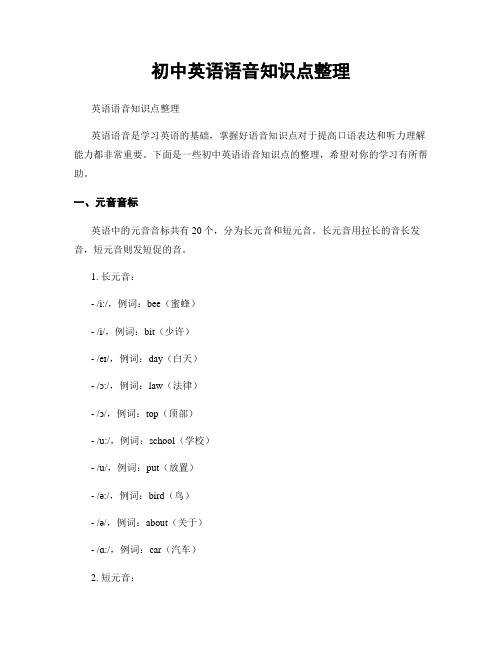
初中英语语音知识点整理英语语音知识点整理英语语音是学习英语的基础,掌握好语音知识点对于提高口语表达和听力理解能力都非常重要。
下面是一些初中英语语音知识点的整理,希望对你的学习有所帮助。
一、元音音标英语中的元音音标共有20个,分为长元音和短元音。
长元音用拉长的音长发音,短元音则发短促的音。
1. 长元音:- /i:/,例词:bee(蜜蜂)- /i/,例词:bit(少许)- /eɪ/,例词:day(白天)- /ɔ:/,例词:law(法律)- /ɔ/,例词:top(顶部)- /u:/,例词:school(学校)- /u/,例词:put(放置)- /ə:/,例词:bird(鸟)- /ə/,例词:about(关于)- /ɑ:/,例词:car(汽车)2. 短元音:- /e/,例词:pen(钢笔)- /æ/,例词:cat(猫)- /ɒ/,例词:hot(热)- /ʌ/,例词:bus(公交车)- /ʊ/,例词:book(书)- /ɜ:/,例词:fur(毛皮)- /ə/,例词:ago(以前)- /ɔ:/,例词:fork(叉子)- /eə/,例词:hair(头发)二、辅音音标英语中的辅音音标共有24个,它们是声音由喉咙、口腔、鼻腔或者唇齿等部位组合发出的音。
1. 爆破音:- /p/,例词:pen(钢笔)- /b/,例词:book(书)- /t/,例词:top(顶部)- /d/,例词:dog(狗)- /k/,例词:cat(猫)- /g/,例词:go(去)2. 摩擦音:- /f/,例词:fish(鱼)- /v/,例词:van(货车)- /θ/,例词:think(思考)- /ð/,例词:this(这个)- /s/,例词:sit(坐)- /z/,例词:zoo(动物园)- /ʃ/,例词:she(她)- /ʒ/,例词:treasure(宝藏)- /h/,例词:happy(快乐)3. 破擦音:- /tʃ/,例词:chat(聊天)- /dʒ/,例词:judge(法官)4. 鼻音:- /m/,例词:man(男人)- /n/,例词:no(不)- /ŋ/,例词:song(歌曲)5. 辅音:- /w/,例词:water(水)- /r/,例词:red(红色)- /l/,例词:left(左边)三、重音规律在英语中,重音是一个很重要的语音规律。
初中英语语音知识点总结
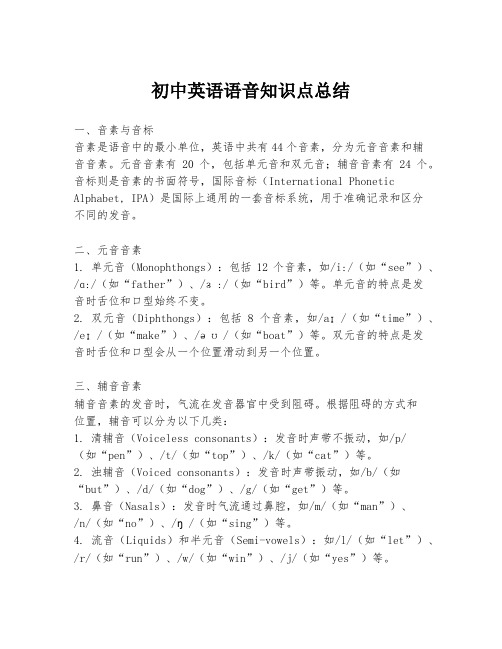
初中英语语音知识点总结一、音素与音标音素是语音中的最小单位,英语中共有44个音素,分为元音音素和辅音音素。
元音音素有20个,包括单元音和双元音;辅音音素有24个。
音标则是音素的书面符号,国际音标(International Phonetic Alphabet, IPA)是国际上通用的一套音标系统,用于准确记录和区分不同的发音。
二、元音音素1. 单元音(Monophthongs):包括12个音素,如/i:/(如“see”)、/ɑ:/(如“father”)、/ɜ:/(如“bird”)等。
单元音的特点是发音时舌位和口型始终不变。
2. 双元音(Diphthongs):包括8个音素,如/aɪ/(如“time”)、/eɪ/(如“make”)、/əʊ/(如“boat”)等。
双元音的特点是发音时舌位和口型会从一个位置滑动到另一个位置。
三、辅音音素辅音音素的发音时,气流在发音器官中受到阻碍。
根据阻碍的方式和位置,辅音可以分为以下几类:1. 清辅音(Voiceless consonants):发音时声带不振动,如/p/(如“pen”)、/t/(如“top”)、/k/(如“cat”)等。
2. 浊辅音(Voiced consonants):发音时声带振动,如/b/(如“but”)、/d/(如“dog”)、/g/(如“get”)等。
3. 鼻音(Nasals):发音时气流通过鼻腔,如/m/(如“man”)、/n/(如“no”)、/ŋ/(如“sing”)等。
4. 流音(Liquids)和半元音(Semi-vowels):如/l/(如“let”)、/r/(如“run”)、/w/(如“win”)、/j/(如“yes”)等。
四、连读与失爆1. 连读(Linking):在句子中,为了发音的流畅性,单词与单词之间会自然地产生连读现象。
如“an apple”中的“an”和“apple”会连读成“anapple”。
2. 失爆(Elision):在快速的口语交流中,某些辅音可能不会被完全发出,这种现象称为失爆。
初中英语语音知识点

初中英语语音知识点以下是初中英语语音方面的一些知识点:1.语音音素:英语中有 44 个语音音素,包括 20 个元音音素和 24 个辅音音素,每个音素都有其特定的发音方式。
2.元音音素:英语中的元音音素有单元音和双元音两种,单元音包括 /i/、/ɪ/、/e/、/æ/、/ʌ/、/ɑ/、/ɔ/、/ʊ/、/u/ 和 /ə/;双元音包括 /eɪ/、/aɪ/、/ɔɪ/、/aʊ/、/oʊ/ 和 /ju:/。
3.辅音音素:英语中的辅音音素包括清辅音和浊辅音两种,清辅音包括 /p/、/t/、/k/、/f/、/θ/、/s/、/ʃ/、/h/、/tʃ/ 和/tr/,浊辅音包括 /b/、/d/、/g/、/v/、/ð/、/z/、/ʒ/、/l/、/r/、/m/、/n/ 和 /ŋ/。
4.重读音节:英语中的重读音节通常是单词中音节的重心,重读音节和非重读音节的音高和音量有明显的区别。
5.连读:英语中的连读是指两个或多个单词在语音上连成一个整体的现象,如“gonna”(going to)和“wanna”(want to)。
6.弱读:英语中的弱读是指非重读音节的发音相对不明显的现象,通常会将弱读音节的元音音素发成 /ə/,例如“the”在句子中常常弱读为/ðə/。
7.语调:英语中的语调包括升调、降调、升降调和平调等,语调能够影响句子的意义和语气。
8.音调:英语中的音调是指单个音节的音高变化,可以分为上升调、下降调和平调三种。
9.假名读音:英语中有很多来自日语的词汇,这些词汇中的假名读音需要特别注意,如“tsunami”(海啸)、“karaoke”(卡拉OK)等。
10.韵律:英语中的韵律是指语音节奏和音量变化的总体规律,通常会受到句型和情感等多方面因素的影响。
11.发音规则:英语中有很多发音规则,例如静音字母、元音音素的长短发音、辅音音素的变化规则等等,需要认真学习和掌握。
12.口音:英语是全球使用最广泛的语言之一,不同地区的英语口音有所差异,例如美式英语、英式英语、澳洲英语等。
听力笔记知识点总结初中

听力笔记知识点总结初中在初中阶段,学生开始接触英语听力,通过听力练习来提高自己的英语听力水平。
在听力学习过程中,有一些重要的知识点需要掌握,下面将对这些知识点进行总结。
一、基本语音知识1. 英语语音的构成英语语音是由元音和辅音组成的,元音包括单元音和双元音,辅音包括浊音和清音。
2. 元音的发音规律英语中元音的发音不仅受到元音本身的调值和力度的影响,还与元音所在的音节位置有关,如重读音节、轻读音节和前元音后元音等。
3. 辅音的发音规律英语中辅音的发音有很多规律,需要根据具体的情况进行掌握,如清浊音的分辨、浊音的不发、辅音精读等。
二、词汇知识1. 单词的拼读规律英语单词的拼读有一定的规律,有些单词的拼读规律需要根据其词根、词缀和外来词的规律进行把握。
2. 词义的辨析在听力中,需要对一些相近的词汇进行辨析,如时态、语态、词义等。
三、句法知识1. 语法结构的应用在听力中需要对一些语法结构的应用进行掌握,如被动语态、主谓一致、名词性从句的使用等。
2. 句子的成分分析在听力中需要对句子的成分进行分析,如主语、谓语、宾语等。
四、听力技巧1. 获取关键信息在听力中需要有辨别能力,找出关键信息,帮助理解整个听力内容。
2. 注意识别重音在听力中需要注意识别重音,这有助于理解句子的重心和重点。
3. 注意语境在听力中需要注重语境的理解,帮助理解句子的意思。
以上是初中英语听力笔记的知识点总结,希望对初中学生们的英语学习有所帮助。
在英语听力学习的过程中,需要多加练习,才能提高自己的英语水平。
新初中英语语音的专项训练及答案(2)
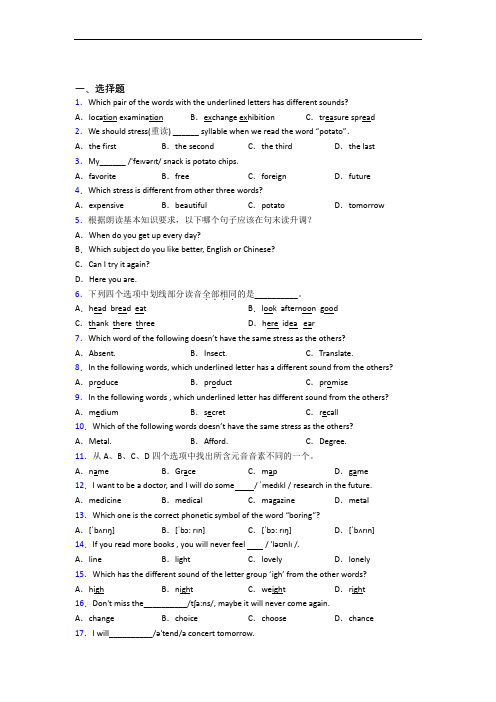
一、选择题1.Which pair of the words with the underlined letters has different sounds? A.location examination B.exchange exhibition C.treasure spread 2.We should stress(重读) ______ syllable when we read the word “potato”.A.the first B.the second C.the third D.the last 3.My______ /'feɪvərɪt/ snack is potato chips.A.favorite B.free C.foreign D.future 4.Which stress is different from other three words?A.expensive B.beautiful C.potato D.tomorrow 5.根据朗读基本知识要求,以下哪个句子应该在句末读升调?A.When do you get up every day?B.Which subject do you like better, English or Chinese?C.Can I try it again?D.Here you are.6.下列四个选项中划线部分读音全部相同....的是__________。
A.head bread eat B.look afternoon goodC.thank there three D.here idea ear7.Which word of the following doesn’t have the same stress as the others? A.Absent. B.Insect. C.Translate.8.In the following words, which underlined letter has a different sound from the others? A.produce B.product C.promise9.In the following words , which underlined letter has different sound from the others? A.medium B.secret C.recall10.Which of the following words doesn’t have the same stress as the others? A.Metal. B.Afford. C.Degree.11.从A、B、C、D四个选项中找出所含元音音素不同的一个。
初中英语语音知识点归纳
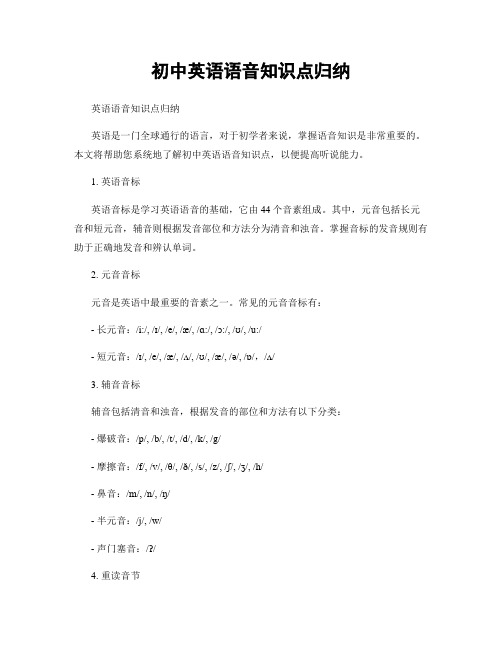
初中英语语音知识点归纳英语语音知识点归纳英语是一门全球通行的语言,对于初学者来说,掌握语音知识是非常重要的。
本文将帮助您系统地了解初中英语语音知识点,以便提高听说能力。
1. 英语音标英语音标是学习英语语音的基础,它由44个音素组成。
其中,元音包括长元音和短元音,辅音则根据发音部位和方法分为清音和浊音。
掌握音标的发音规则有助于正确地发音和辨认单词。
2. 元音音标元音是英语中最重要的音素之一。
常见的元音音标有:- 长元音:/i:/, /ɪ/, /e/, /æ/, /ɑ:/, /ɔ:/, /ʊ/, /u:/- 短元音:/ɪ/, /e/, /æ/, /ʌ/, /ʊ/, /æ/, /ə/, /ɒ/,/ʌ/3. 辅音音标辅音包括清音和浊音,根据发音的部位和方法有以下分类:- 爆破音:/p/, /b/, /t/, /d/, /k/, /g/- 摩擦音:/f/, /v/, /θ/, /ð/, /s/, /z/, /ʃ/, /ʒ/, /h/- 鼻音:/m/, /n/, /ŋ/- 半元音:/j/, /w/- 声门塞音:/ʔ/4. 重读音节英语单词中的音节可以分为重读和非重读音节。
重读音节是发音比较强烈和明显的音节,而非重读音节则相对弱化。
在英语中,重读音节通常有较长的元音,并且受到语气和语调的影响。
5. 连读英语中的连读是指在快速的语音流中,两个或多个单词之间的边界变得模糊,发音合并成为一个词组音。
常见的连读包括连接音、浊化和辅音变异等。
6. 弱读在英语中,有些词在句子中起到连接和表达语法关系的作用,因此它们的发音通常较弱。
这些词包括冠词(a, an, the)、助动词(be, do, have等)、连词(and, but, or等)和代词(he, she, it等)。
弱读的发音通常非常简化,常见的变化有省略或读作/s/音。
7. 音变规则英语中的音变规则是指语音变化在特定条件下的变化。
九年级英语单词发音
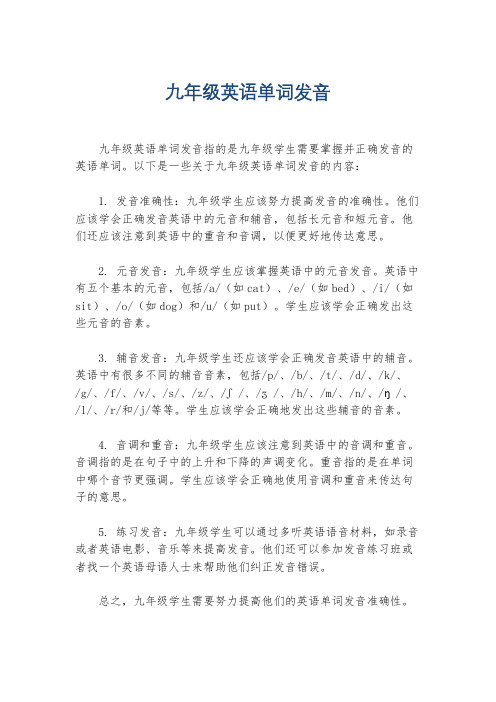
九年级英语单词发音
九年级英语单词发音指的是九年级学生需要掌握并正确发音的英语单词。
以下是一些关于九年级英语单词发音的内容:
1. 发音准确性:九年级学生应该努力提高发音的准确性。
他们应该学会正确发音英语中的元音和辅音,包括长元音和短元音。
他们还应该注意到英语中的重音和音调,以便更好地传达意思。
2. 元音发音:九年级学生应该掌握英语中的元音发音。
英语中有五个基本的元音,包括/a/(如cat)、/e/(如bed)、/i/(如sit)、/o/(如dog)和/u/(如put)。
学生应该学会正确发出这些元音的音素。
3. 辅音发音:九年级学生还应该学会正确发音英语中的辅音。
英语中有很多不同的辅音音素,包括/p/、/b/、/t/、/d/、/k/、/g/、/f/、/v/、/s/、/z/、/ʃ/、/ʒ/、/h/、/m/、/n/、/ŋ/、/l/、/r/和/j/等等。
学生应该学会正确地发出这些辅音的音素。
4. 音调和重音:九年级学生应该注意到英语中的音调和重音。
音调指的是在句子中的上升和下降的声调变化。
重音指的是在单词中哪个音节更强调。
学生应该学会正确地使用音调和重音来传达句子的意思。
5. 练习发音:九年级学生可以通过多听英语语音材料,如录音或者英语电影、音乐等来提高发音。
他们还可以参加发音练习班或者找一个英语母语人士来帮助他们纠正发音错误。
总之,九年级学生需要努力提高他们的英语单词发音准确性。
通过学习正确的元音和辅音发音,注意音调和重音,以及进行发音练习,他们将能够更好地掌握英语单词的发音。
初中英语单词,词组 语音记忆分类记忆(二)
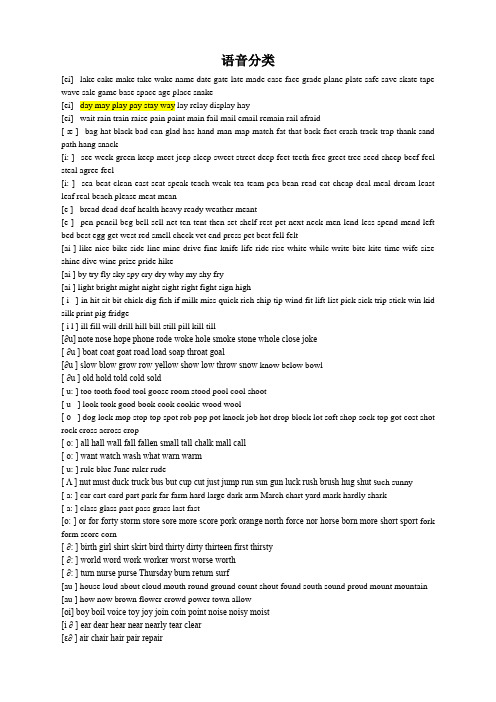
语音分类[ei] lake cake make take wake name date gate late made case face grade plane plate safe save skate tape wave sale game base space age place snake[ei] day may play pay stay way lay relay display hay[ei] wait rain train raise pain paint main fail mail email remain rail afraid[ æ ] bag hat black bad can glad has hand man map match fat that back fact crash track trap thank sand path hang snack[i: ] see week green keep meet jeep sleep sweet street deep feet teeth free greet tree seed sheep beef feel steal agree feel[i: ] sea beat clean east seat speak teach weak tea team pea bean read eat cheap deal meal dream least leaf real beach please meat mean[e ] bread dead deaf health heavy ready weather meant[e ] pen pencil beg bell sell net ten tent then set shelf rest pet next neck men lend less spend mend left bed best egg get west red smell check vet end press pet best fell felt[ai ] like nice bike side line mine drive fine knife life ride rise white while write bite kite time wife size shine dive wine prize pride hike[ai ] by try fly sky spy cry dry why my shy fry[ai ] light bright might night sight right fight sign high[ i ] in hit sit bit chick dig fish if milk miss quick rich ship tip wind fit lift list pick sick trip stick win kid silk print pig fridge[ i l ] ill fill will drill hill bill still pill kill till[∂u] note nose hope phone rode woke hole smoke stone whole close joke[ ∂u ] boat coat goat road load soap throat goal[∂u ] slow blow grow row yellow show low throw snow know below bowl[ ∂u ] old hold told cold sold[ u: ] too tooth food tool goose room stood pool cool shoot[ u ] look took good book cook cookie wood wool[ о] dog lock mop stop top spot rob pop pot knock job hot drop block lot soft shop sock top got cost shot rock cross across crop[ о: ] all hall wall fall fallen small tall chalk mall call[ о: ] want watch wash what warn warm[ u: ] rule blue June ruler rude[ Λ ] nut must duck truck bus but cup cut just jump run sun gun luck rush brush hug shut s uch sunny[ a: ] car cart card part park far farm hard large dark arm March chart yard mark hardly shark[ a: ] class glass past pass grass last fast[о: ] or for forty storm store sore more score pork orange north force nor horse born more short sport fork form score corn[ ∂: ] birth girl shirt skirt bird thirty dirty thirteen first thirsty[ ∂: ] world word work worker worst worse worth[ ∂: ] turn nurse purse Thursday burn return surf[au ] house loud about cloud mouth round ground count shout found south sound proud mount mountain [au ] how now brown flower crowd power town allow[оi] boy boil voice toy joy join coin point noise noisy moist[i ∂ ] ear dear hear near nearly tear clear[ε∂ ] pear wear bear appea r[ei]cake 糕点gate 大门plane 飞机make 制造late 迟到plate 碟子take 拿、带made 制造(过去式) safe 安全的wake 醒、叫醒case 箱子save 挽救name 名字wave 波浪skate 溜冰tape 录音带face 脸sale 出售game 游戏base 基地、基础snake 蛇space 太空age 年龄place 地方lake 湖泊date 日期grade 年级[ei]day 日may 可以play 玩pay 付款stay 逗留way 道路、方法lay 下蛋relay 接力display 展出[ei] afraid 害怕、担心wait 等待rain 下雨、雨train 火车raise 提高、升起pain 疼痛paint 油漆main 主要的fail 失败、不及格, mail 邮件email 电子邮件remain .保持, 逗留rail 铁轨[ æ ] hang 悬挂, snack 小吃, 快餐bag 包hat 帽子black 黑的bad 坏的can 能够glad 高兴的has 有(第三人称)hand 手man 男人map 地图match 比赛fat 肥的that 那back 背部、后面fact 事实crash .碰撞, 坠落track .轨迹, 车辙trap 圈套, 陷阱thank 感谢sand 沙子path 小道[i: ]see 看见week 星期green 绿色的keep 保持meet 遇见、会见jeep 吉普车sleep 睡觉sweet 甜的street 街道deep 深的feet 脚(复数)teeth 牙齿(复数)free 空闲的greet t.问候, tree 树seed 种子sheep 绵羊beef 牛肉feel 感觉steal 偷agree 同意[i: ] mean 意思、用意sea 海beat 打clean 干净的east 东面seat 座位speak 讲teach 教weak 弱的tea 茶team 队pea 豌豆bean 豆deal .处理、交易meal 一餐dream 发梦least 最少leaf 树叶real 真正的beach 海滩please 请meat 肉weather 天气[e ] meant 用意(过去式)bread 面包dead 死的deaf 聋的health 健康heavy 重的ready .有准备的[e ] west 西方pen 钢笔pencil 铅笔bell 铃sell 卖net beg .请求, 乞求ten 十neck 脖子next 下一个pet 宠物rest 休息shelf 架子set 树立、一套then 然后tent 帐篷men 男人(复数)lend 借给less 较少bed 床left 左边spend 花费mend 修理best 最好egg 蛋get .获得、到达felt 感觉(过去式) fell 跌下(过去式vet 兽医press .压, 按end 末端、结束red 红色的check 检查smell 闻[ai ] prize 奖赏、奖品wine 葡萄酒like 喜欢nice 好的、和蔼的bike 自行车line 线、绳、排队drive 驾驶side 边mine 我的knife 刀ride 骑fine 美美好的、优良的 while 一会儿, rise 上升, 增加write 写white 白色的life 生活kite 风筝time 时间wife 妻子bite 咬shine 照耀pride .自豪size 尺寸, 尺码hike 远足dive 潜水[ai ]by 在附近fly 飞sky 天空spy 间谍my 我的fry 油炸, 油煎shy 害羞的why 为什么dry 干燥的cry 哭try 尝试[ai ]light 轻的bright 明亮的might 可能night 晚上sight 视力right 右边、对的fight 战斗、.打架sign 标志、签名high 高的[ i ]in 在。
初中英语语音知识

初中英语语音知识语音是人们交流思想的工具,人们交流思想主要是通过语音(即听和说)的形式来进行的。
所以说,语音对于学习一种语言是十分重要的。
语音即人们说话的声音。
英语的语音内容主要锯括48音标、26个字母、读音规则及语言在单词和句子中的基本特征。
英语是拼音文字,基音、形之间有着必然的联系,联系的“桥梁“就是读音规则。
掌握了英语的读音规则,不仅是学习英语这种语言的需要,同时也是记忆单词,运用语言的需要。
掌握了读音规则,记忆单词时就可以“见形知音”或“听音知形”,提高记忆效率。
例如当我闪知道字母b读/b/,字母o读/o/字母x读/kx/时,就可以看到box这个词时知道它的读音是/boks/,听到读/boks/就知道拼写形式是box。
而且,识记英语单词时,根据单词的读音联想记忆单词的书写形式比先记形后记读音容易得多。
例如congrat ulation(祝贺)这个单词,它有5个音节,词形是14个字母,同学们可以试一试,得到的结论一定是先记读音比先记词形容易得多。
掌握了科学有效的学习方法,学生完全可以自行进行尝试学习,也就是学生能尝试,尝试能成功,成功能创新。
第一节英语音标尝试记忆法音标是构成语音的最小单位,音标是音素的书写符号。
音素是听觉概念,音标是视觉概念。
如当我们听到或读出/i:/的声音是时,/i:/是一个音素;当我们看到或把/i:/写出来时,/i:/就叫音标。
音标都写在[]或//内,是为了把音标和一些小写字母区别开来。
英语一共有48个音素,书写出来就是48个音标。
在语音知识中,音标是最基础的内容,先学音标可以为学习字母的读音打下基础,音素双可分为元音音素和辅音音素。
元音音素又分为单元音和双元音,辅音音素根据发音时声带振动与否又分为清音和浊音。
音素(48个)元音音素(20个)单元音(12个)双元音(8个)辅音音素(28个)清音(11个)浊音(15个)半元音(2个)。
初中英语语音知识点
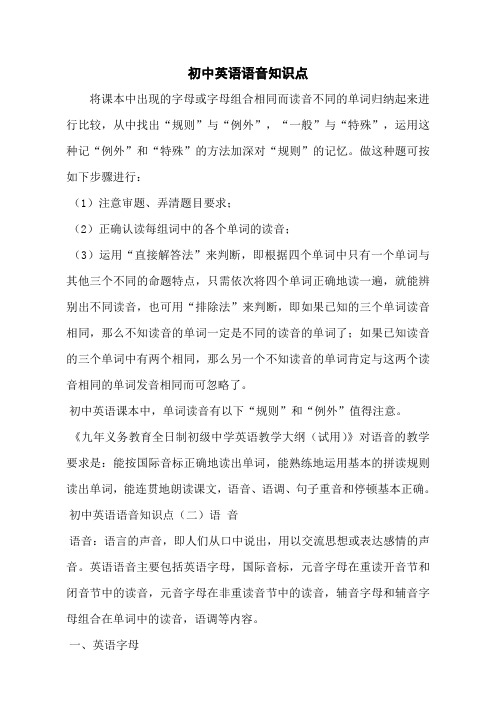
初中英语语音知识点
将课本中出现的字母或字母组合相同而读音不同的单词归纳起来进行比较,从中找出“规则”与“例外”,“一般”与“特殊”,运用这种记“例外”和“特殊”的方法加深对“规则”的记忆。
做这种题可按如下步骤进行:
(1)注意审题、弄清题目要求;
(2)正确认读每组词中的各个单词的读音;
(3)运用“直接解答法”来判断,即根据四个单词中只有一个单词与其他三个不同的命题特点,只需依次将四个单词正确地读一遍,就能辨别出不同读音,也可用“排除法”来判断,即如果已知的三个单词读音相同,那么不知读音的单词一定是不同的读音的单词了;如果已知读音的三个单词中有两个相同,那么另一个不知读音的单词肯定与这两个读音相同的单词发音相同而可忽略了。
初中英语课本中,单词读音有以下“规则”和“例外”值得注意。
《九年义务教育全日制初级中学英语教学大纲(试用)》对语音的教学要求是:能按国际音标正确地读出单词,能熟练地运用基本的拼读规则读出单词,能连贯地朗读课文,语音、语调、句子重音和停顿基本正确。
初中英语语音知识点(二)语音
语音:语言的声音,即人们从口中说出,用以交流思想或表达感情的声音。
英语语音主要包括英语字母,国际音标,元音字母在重读开音节和闭音节中的读音,元音字母在非重读音节中的读音,辅音字母和辅音字母组合在单词中的读音,语调等内容。
初中英语教资语音课知识点
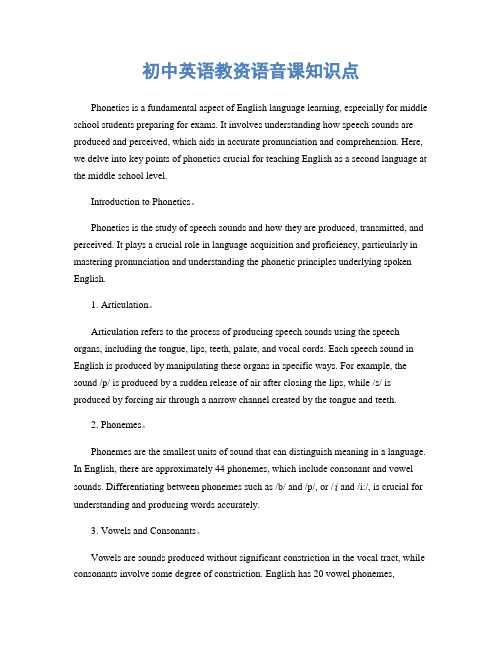
初中英语教资语音课知识点Phonetics is a fundamental aspect of English language learning, especially for middle school students preparing for exams. It involves understanding how speech sounds are produced and perceived, which aids in accurate pronunciation and comprehension. Here, we delve into key points of phonetics crucial for teaching English as a second language at the middle school level.Introduction to Phonetics。
Phonetics is the study of speech sounds and how they are produced, transmitted, and perceived. It plays a crucial role in language acquisition and proficiency, particularly in mastering pronunciation and understanding the phonetic principles underlying spoken English.1. Articulation。
Articulation refers to the process of producing speech sounds using the speech organs, including the tongue, lips, teeth, palate, and vocal cords. Each speech sound in English is produced by manipulating these organs in specific ways. For example, the sound /p/ is produced by a sudden release of air after closing the lips, while /s/ is produced by forcing air through a narrow channel created by the tongue and teeth.2. Phonemes。
- 1、下载文档前请自行甄别文档内容的完整性,平台不提供额外的编辑、内容补充、找答案等附加服务。
- 2、"仅部分预览"的文档,不可在线预览部分如存在完整性等问题,可反馈申请退款(可完整预览的文档不适用该条件!)。
- 3、如文档侵犯您的权益,请联系客服反馈,我们会尽快为您处理(人工客服工作时间:9:00-18:30)。
解析:B
【解析】
【分析】
【详解】
试题分析:句意:下列各组字母全部是元音字母的是a,i,u,e。根据字母的发音可知a [ei],e [i:],i [ai],o [əu],u [ju:],故选B。
5.B
解析:B
【解析】
【分析】
【详解】
试题分析:句意:沿着这条街走向左拐,你将在你的前面看到一个图书馆。
A.Have youever worked with either of them?B.He didn’teven look at it.
C.We saved him from theenemy.D.Can you tell me who invented the telephone?
18.Which of the following pronunciation(发音) is different?
A.idleB.ideaC.idiomD.identify
16.I will__________/ə'tend/a concert tomorrow.
A.aloudB.attendC.aheadD.afford
17.Which of the following underlined parts is different in pronunciation with others?
8.C
解析:C
【解析】
【分析】
【详解】
考查单词读音,A. mother[ˈmʌðə];B.their [ðɛː];C.thing [θɪŋ];D.these [ðiːz],对比可知,故选C。
9.B
解析:B
【解析】
【分析】
【详解】
考查字母的读音。Ff的发音是[ef], Ll的发音是[el],Hh的发音是[eɪtʃ];Gg的发音是[dʒi:],Tt的发音是[ti:],Zz的发音是[zi:];Bb的发音是[bi:],Dd的发音是[di:], Jj的发音是[dʒeɪ];Aa的发音是[eɪ],Kk的发音是[keɪ],Xx的发音是[eks]。所以B选项中的字母有相同的因素[i:],故选B。
A.cakeB.faceC.appleD.late
12.She didn't have a good_____/ sli:p/ last night, so she looked tired.
A.sleepB.sheepC.shapeD.shop
13.从A、B、C、D四个选项中找出所含元音音素不同的一个。
解析:D
【解析】
【详解】
句意:哪个发音和其他的不一样?
考查元音字母发音。win音标是[wɪn],i发[ɪ];with音标是[wɪð],i发[ɪ];king音标是[kɪŋ],i发[ɪ];rice音标是[raɪs],i发[aɪ]。通过对比可知,rice中的字母i与其它三个发音不同,故选D。
15.C
解析:C
7.C
解析:C
【解析】
【分析】
【详解】
When do you get up every day?你每天什么时候起床?这是特殊疑问句,英语中特殊疑问句用降调读;Which subject do you like better, English or Chinese?英语和语文你更喜欢哪个科目?英语中特殊疑问句用降调读;Can I try it again?我能再试一次吗?一般疑问句,英语中一般疑问句用升调读;Here you are.给你;陈述句一般用降调读;综合之后可以看出,应该选择C选项比较合适,故选C。
A.expensiveB.beautifulC.potatoD.tomorrow
7.根据朗读基本知识要求,以下哪个句子应该在句末读升调?
A.When do you get up every day?
B.Which subject do you like better, English or Chinese?
A.cuteB.umbrellaC.musicD.pupil
19.Which of the words is between “hello” and “often” in the dictionary?
A.hearB.theirCe following is WRONG? ________
A.volunteersB.oftenC.communityD.centre
25.In the following words , which underlined letter has different sound from the others?
A.mediumB.secretC.recall
3.B
解析:B
【解析】
【详解】
句意:读“土豆”一词时,我们应该重读第二个音节。
考查单词的读音。A. the first第一个;B. the second第二个;C. the third第三个;D. the last最后一个。单词potato的发音是/pəˈteɪtəu/,重音在第二个音节,要重读,故选B。
A.What do you do at weekends? B.I often watch films on TV at home.
C.Do you think it is boring? D.Yes, I hope to play with friends.
21.How many syllables(音节) does the word “lovely” have?
A.a, e, o, rB.a, i, u, eC.o, u, e, n
5.Go down this street and turn ______ / left / .You will see a library in front of you.
A.lightB.leftC.letD.lift
6.Which stress is different from other three words?
C.Can I try it again?
D.Here you are.
8.下列单词中画线部分的读音不同的是______。
A.motherB.theirC.thingD.these
9.选出下列字母中都含有相同音素的一组字母:________。
A.Ff; Ll; HhB.Gg;Tt; Zz .
C.Bb; Dd; JjD.Aa;Kk; Xx
A.One.B.Two.C.Three.D.Four.
22.Which of the underlined letter has a different pronunciation?
A.thereB.clothesC.bothD.those
23.Which of the following words contain the pronunciation /ɪ/?
10.C
解析:C
【解析】
【分析】
【详解】
题意:下列四个选项中,哪个画线字母的发音与其他字母不同?
考查其他字母组合发音。A. northern画线部分读音为[ɔː];B. abroad画线部分读音为[ɔː];C. block画线部分读音为[ɒ];D. before画线部分读音为[ɔː(r)]。C选项画线部分发音与其他三项不同,故选C。
一、选择题
1.which of the following words has a different stress(重音)?
A.countryB.famousC.outsideD.repeat.
2.Could you help clean up the classroom? It's/'dɜ: ti/.
A.feelB.realC.childrenD.suit
24.When we read “Volunteers often meet at the community centre”, we stress (重读) the second syllable (音节) of the word “__________”.
11.C
解析:C
【解析】
【分析】
【详解】
题意:选出单词中字母的发音于其他不同的。
考查元音字母的发音。cake [keɪk];face [feɪs];apple [ˈæpl];late [leɪt]。故选C。
【点睛】
元音字母在重读开音节中一般发字母本身音(元音字母都读它们字母表的音名)。重读开音节包括绝对开音节和相对开音节。(1)以一个发音的元音字母结尾的重读音节,叫做绝对开音节。(2)“一个元音字母+辅音字母(r除外)+不发音e结尾”的重读音节,叫做相对开音节。cake、face、late是相对开音节,字母a读字母表的音名/eɪ/;apple有两个音节,“ap”是一个音节,“ple”是一个音节;其中第一个音节是闭音节,且重读,即“ap”是重读闭音节,a在重读闭音节中发/æ/。
13.C
解析:C
【解析】
【详解】
考查辨音,注意识记a在不同单词中的发音规律。name[neɪm],元音音素为[eɪ];Grace[ɡreɪs],元音音素为[eɪ];map [mæp],元音音素为[æ];game[geɪm],元音音素为[eɪ]。选项C中的单词元音音素与其他选项的不同,故选C。
14.D
考查单词的发音。根据发音可知是左边left。A. light轻的;B. left左边;C. Let让;D. Lift电梯。故选B。
6.B
解析:B
【解析】
【分析】
【详解】
句意:哪一个单词的重读不同于其他三个单词的重读?
本题考查音标。A. expensive /ɪkˈspensɪv/,B. beautiful /ˈbjuːtɪfl/,C. potato /pəˈteɪtəʊ/,D. tomorrow/təˈmɒrəʊ/。故选B。
